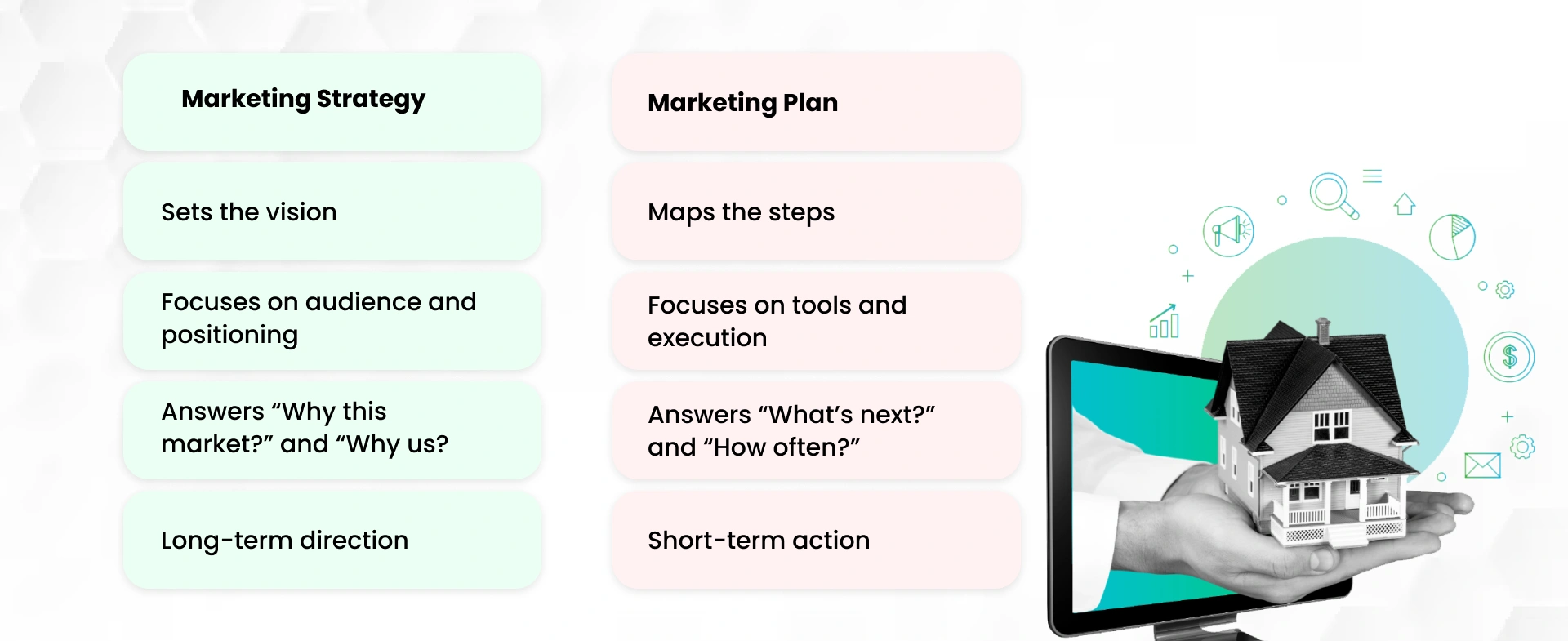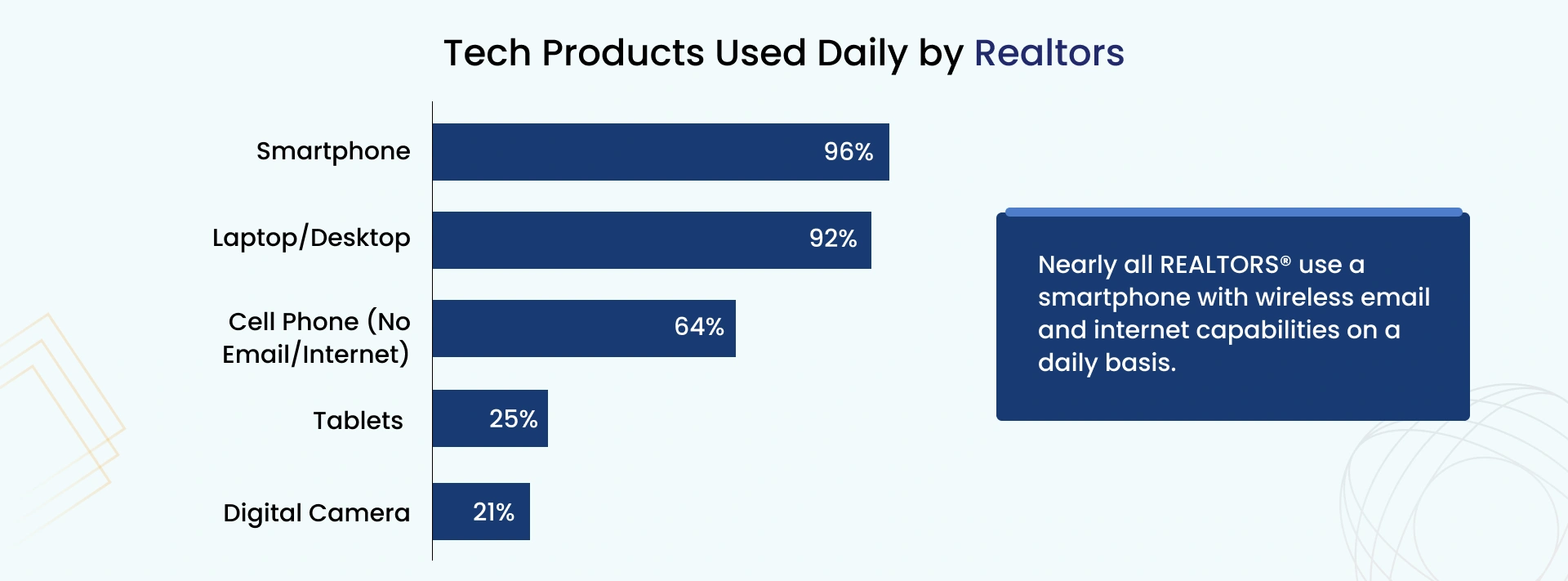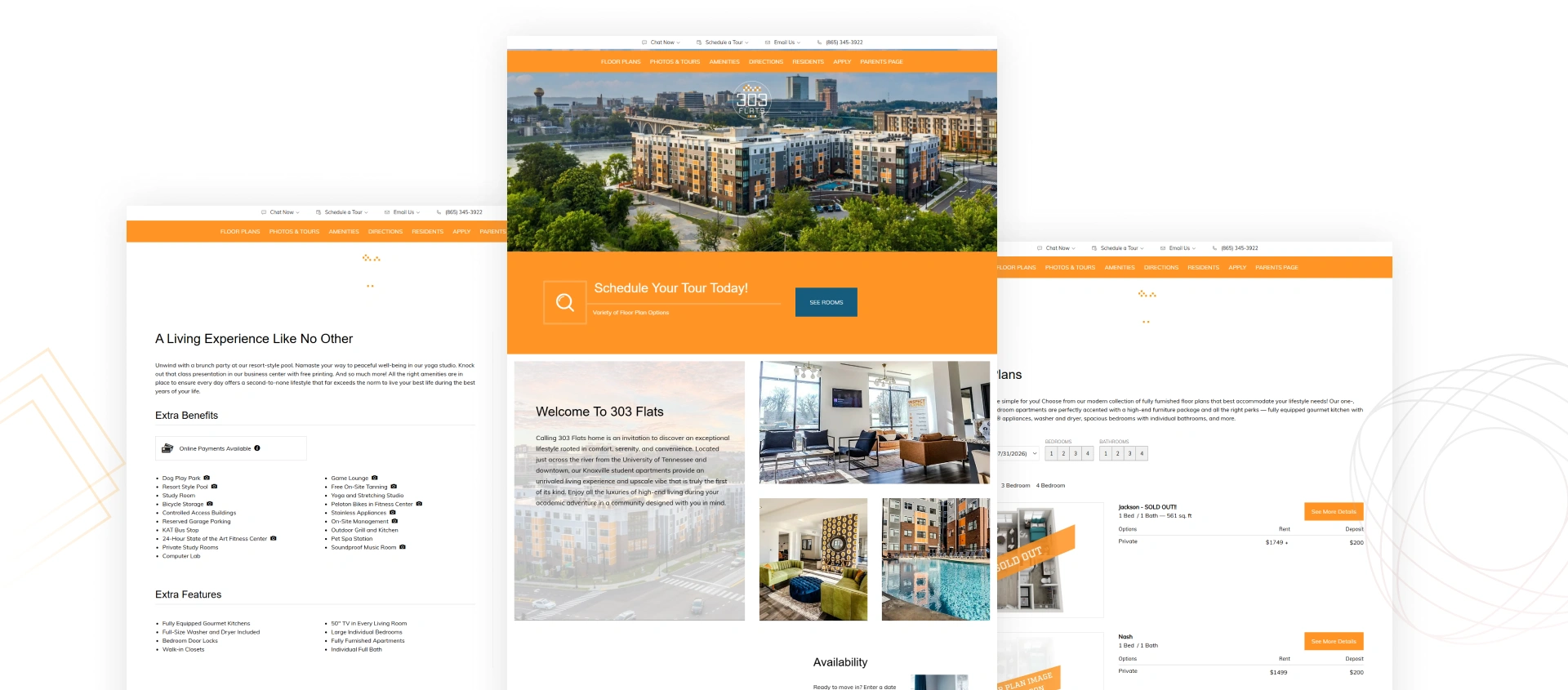
Many real estate agents struggle to market themselves in a way that brings steady leads and real business growth. They post on social media, run ads, or send emails, but these efforts often fall flat without a clear plan. A lot of time and money are spent without knowing what’s working. The truth is that marketing in real estate today is more competitive than ever. Buyers and sellers are doing their homework online. They compare agents, read reviews, and expect quick answers. You get ignored if your message isn’t clear or your brand doesn’t stand out. That’s where a real estate marketing plan comes in, one built on strong digital marketing services that help you get noticed and stay ahead.
Our strategies have helped clients attract more qualified leads, shorten sales cycles, and strengthen their brand presence in both local and digital spaces. By focusing on what drives buyer and seller decisions, we’ve seen agents go from inconsistent outreach to becoming the go-to name in their area. This blog shares the same practical steps we use with our clients so you can create a marketing plan that looks good on paper and helps you grow. Whether you're in a competitive urban market or serving a tight-knit community, these insights are built to help you stand out and stay ahead with real estate ideas for marketing that work in today’s market.
A real estate marketing plan serves as your growth blueprint. It specifies the methods you will use to engage the right customers, advertise your offerings, and establish a brand that your local market will recognize. A solid marketing plan consists of the target audience, competitor analysis, a unique value proposition (UVP), primary marketing channels, and a budget, all working together to maximize productivity and effectiveness.
In today’s landscape, nearly 9 out of 10 buyers find their home through online platforms before ever speaking with an agent. This indicates that a digital presence is no longer optional; it is, rather, the gateway to new prospects. A strategic, reliable marketing plan ensures that you reach the visibility and attention of buyers and sellers during their search, with the right call to action.

Posting and sending emails without a unified strategy is one of the most common blunders real estate agents tend to make. Everything from content creation, branding, goals, and messaging must coincide, and only a comprehensive real estate marketing plan can provide you with the direction you need as a realtor.
But to construct a plan that will succeed, you must first understand how it differs from your overall marketing strategy, as combining them can lead to confusion, wasted effort, and missed opportunities. Let's break it down.
Strategy and planning are often used interchangeably, as if they have the same meaning. However, they serve very different functions, and confusing them can result in lost time, fragmented efforts, and sluggish results.
A marketing strategy is the why behind it all. It determines your objectives, your target audience, and your point of difference in the marketplace. It's the foundation that provides direction and purpose to your endeavors. Without a strategy, your marketing becomes mere noise.
A marketing plan, on the other hand, is the how. It’s the execution playbook: the steps you’ll take, the tools you’ll use, and the content you’ll deliver to bring your strategy to life. It covers what you'll say, where you'll say it, how you'll say it, and how you'll measure success.
Think of it like this:

For example, your strategy is to win trust from first-time buyers in emerging neighborhoods. In that case, your plan might include weekly blog posts that break down the homebuying process, social media content that highlights affordable listings, and email sequences that guide new leads from interest to action.
The strategy provides the tone. The plan makes it happen.
Having one but not the other doesn't cut it. A plan without a strategy causes growth to stall. A strategy without a plan results in busywork that goes nowhere.
It is only when both come together with clarity, purpose, and consistency that the real impact is realized.
The following 10 steps break down everything you need to craft a focused, results-driven real estate marketing plan. From identifying your ideal clients to choosing the proper channels and crafting your message, each step is designed to help you move with clarity and confidence in a competitive market.

Every winning real estate marketing plan begins with clarity about who you serve. You must know if you're targeting buyers, sellers, investors, or renters. This helps you choose the right real estate marketing ideas that match their specific needs.
Each group thinks differently. A first-time buyer looks for safety and affordability. A luxury seller focuses on value and privacy. When you understand who they are, your message becomes stronger and more personal.
To understand your audience deeply, try using the 4D method: Discomforts, Doubts, Dreams, and Drivers. This helps you look beyond surface-level details and focus on what truly matters to your buyers or sellers.
Discomforts are the pain points your audience feels. These could be things like long selling times, confusing paperwork, or not knowing if they’re getting the right deal.
Doubts are the questions running through their minds. “Is now a good time to buy?” “Can I trust this agent?” “What if I lose money?”
Dreams are what they want. Maybe it’s owning a home in a great school district, selling fast so they can relocate, or investing smartly to build wealth.
Drivers are the triggers that push them to take action, like rising interest rates, a growing family, or seeing their dream home come on the market.
The more detail you add, the easier it becomes to create listings, ads, and offers that feel made just for them.
Build short client profiles. Note their age, income, lifestyle, and needs. When you define your ideal client well, every part of your marketing, from emails to listings, works smarter and yields better results.
Your real estate marketing strategies can't live in a bubble. You must know who you're up against and what they're doing right or wrong.
The best way to do this is to step back and look at your local competition through a clear lens. By analyzing other agents and firms in your area, you learn what makes them click, where they miss the mark, and how you can do things differently and better. Two simple exercises can help.
This method gives you a fast way to break down your competition. It focuses on what they aim for, how they operate, how they perform, and where they miss out. Here's how to use it:

Start by figuring out what your competitors want. Are they chasing high-volume listings? Do they focus only on luxury properties? They may position themselves as neighborhood experts. When you understand their goals, you see the direction of their entire marketing plan. These insights can help you shape stronger marketing strategies in real estate and build a more innovative marketing plan for real estate agency growth.
If a local agent positions herself as a luxury expert, her goal is likely high-value listings with high commissions. Her marketing will focus on elegance, premium visuals, and white-glove service.
Now look at how they try to reach their goals. What tone do they use in their listings? Do they rely on video tours, social media, or direct mail? Is their brand modern, traditional, playful, or professional?
Their approach tells you how they connect with clients. If their tone feels cold or outdated, that’s your opening to be warm, clear, and modern.
Check what results they seem to get. Do they have strong reviews? A lot of listings? Are they closing deals quickly? Check their Google reviews, Zillow ratings, and how frequently their listings change status.
You’re not just guessing; you're tracking real signs of success. This gives you a benchmark for your own marketing goals.
Finally, study what they don’t do. Do they ignore video content? Is their website outdated? Do they take a while to respond on social media? Do they lack personality in their branding?
These gaps are your most significant opportunities. Clients notice what’s missing, especially when you offer it.
The GAPS method helps you spot exactly where your competitors stand and where you can stand out. You learn what goals they’re chasing, how they present themselves, what results they’re getting, and what they’re missing. This gives you a complete picture of their marketing strategy. The real win? You see the gaps they leave behind. Those gaps become your chance to offer something better, more helpful, and more unique to your target clients, primarily when supported by clear marketing strategies in real estate.
This second exercise zooms out a bit. Instead of focusing only on one agent, you look at the local real estate scene as a whole. Use these five questions to find real insight and shape your marketing strategies for real estate effectively:
Look at how many agents and firms operate in your city, town, or neighborhood. Are you in a tight market with hundreds of listings or a niche zone with just a few players? This tells you how bold or focused your real estate marketing strategy must be.
Visit review sites and Facebook groups. What do home buyers and sellers say about agents? Are they unhappy with slow replies, poor follow-up, or lack of trust? Use this to guide your tone, service, and messaging. This insight can also guide your future real estate marketing techniques to better meet client expectations.
Sometimes, everyone copies each other. You’ll see the same kind of listings, boring email templates, or outdated designs. This is your chance to stand out. If others zig, you zag.
Are agents using virtual tours, drone shots, or Instagram Reels? Are they still stuck in print ads and flyers? Knowing what tech is standard (or missing) helps you upgrade your marketing without guessing. It also helps you decide which real estate marketing technique gives you a competitive edge.
This is the golden question. What are clients still searching for? No one offers bilingual services. Maybe no one speaks to remote workers. No one explains financing in simple terms. That’s your spot to own.
This exercise gives you a clear view of your entire market. You find out how many agents you’re competing with, what genuine buyers and sellers are frustrated about, and what everyone seems to do the same. You also learn what tools are being used and which are being ignored. Most importantly, you discover what clients still want but can’t find. That insight helps you build a real estate marketing strategy that hits the right spot, right on time.
In a competitive real estate market, what distinguishes you from the rest can propel you forward. Begin by determining what your greatest strengths are. You may be a tech expert, extremely dependable, or great with anxious clients who are new to the market. These traits and characteristics set you apart from the competition. These are the strengths that people can rely on you for and help define your real estate marketing strategy.
Next, turn those strengths into a clear USP (Unique Selling Proposition). This is a short line that sums up your value. Example: “Helping first-time buyers feel confident from day one.” It’s short, powerful, and speaks to someone’s real need.
Here’s a quick way to build your USP:
When your branding and voice align with your strengths, people take notice. They remember you. They trust you. And that makes all your real estate marketing ideas work better. The clearer your message, the easier it is to attract the right clients.
Your message is the core of your brand. It’s what people remember after reading your ad, listing, or website. A strong message doesn’t just sound good; it speaks to the real needs of your audience. It also plays a key role in shaping your overall real estate marketing strategy.
To build a strong marketing message, use this 3-part formula:
Buyers and sellers have real fears. “Will I overpay?” “Will my home sit too long?” “Can I trust this agent?” Start your message by showing you understand these worries.
Explain what result you deliver. Example: “Get your home sold in 30 days at the right price.” Don’t talk about features. Talk about the outcome you helped create.
What makes you a better choice? Faster communication? Better marketing? Local expertise? Add that in one line to stand out.
When your message speaks directly to the right people, everything gets easier. Your ads get more clicks. Your listings attract better leads. Your emails get replies. People start to feel like you're the agent or team who “gets it.” And when that happens, they don’t just choose you, they trust you, refer you, and stay loyal. That’s the power of clear messaging backed by strong real estate marketing ideas.
Your marketing budget sets the pace for how fast you grow. For most real estate professionals, a good rule of thumb is to spend about 10–15% of your gross commission income on marketing. If you’re just starting out or aggressively trying to grow, you can stretch this up to 20%, especially in competitive markets. Having a well-planned real estate marketing strategy helps ensure that your budget is being used where it matters most.

This budget should cover everything from paid ads and website costs to photography, video, automation tools, and even content writing. The goal isn’t to spend big but to allocate wisely. Focus on channels and tools that bring in measurable results. Over time, analyze what’s working, eliminate ineffective strategies, and reinvest in the most effective ones. This is where using proven conversion rate optimization (CRO) services helps improve performance and reduce waste.
Implement PPC services as a short-term tactic and email marketing solutions as long-term strategies. Some initiatives require time for implementation but offer exponential growth. Continuously analyze outcomes as you scale. Document the outcomes of every dollar spent, whether it is increased traffic, qualified leads, or converted customers, and redistribute funding to the most valuable channels.
Your marketing channels determine where and how your brand appears. Selecting the correct ones allows you to reach the correct people without wasting time or money. Rather than attempting to be everywhere, concentrate on where your ideal clients already spend their time. Strong marketing strategies in real estate begin with choosing the right platforms to match your goals and audience.

Social media is a good place to start for most agents. Tools like Instagram, Facebook, and YouTube allow you to post property listings, share news, and share success stories about your clients. These media are best suited for establishing trust and being top of mind. If your target market is searching regionally, you also need to appear on Google Maps, real estate directory sites, and local listing sites. This is an essential step when building a strong marketing plan for real estate agency growth. A strong digital marketing strategy in real estate helps you stay on track and maximize every investment. The following are the most effective media real estate professionals can use and how to utilize each of them with proven real estate ideas for marketing:

Platforms like Instagram, Facebook, TikTok, and YouTube are perfect for real estate. Use them in conjunction with innovative social media marketing strategies to post property listings, share news, and share success stories about your clients.
This free tool helps you appear in local searches and on Google Maps. When someone searches for “real estate agent near me,” you want your profile to appear. Add reviews, photos, contact info, and updates to improve trust and visibility.
Websites like Zillow, Realtor.com, and Redfin are still powerful. Many buyers begin their journey here. Listing your properties on these sites increases exposure, but don’t rely on them alone - use them to complement your other marketing strategies.
Email marketing is great for staying top of mind. Send newsletters, new listings, open house invites, and market tips. It works well for nurturing cold leads or bringing back past clients and referrals.
A professional website with SEO-optimized content helps people find you on Google. Write about your area, share blogs, and highlight listings. Strong local SEO ensures your site ranks when someone searches for homes or agents in your area.
Yes, it still works, especially in specific neighborhoods or demographics. Send postcards, newsletters, or flyers with property updates, market stats, or recent sales. Use it as a personal touch alongside your digital efforts.
Face-to-face marketing is powerful. Hosting events or attending community gatherings helps build relationships and grow referrals. Don’t just sell, show you care about the community. These personal connections are also great real estate marketing ideas that build long-term trust.
Content is the most effective way to establish trust, stay top of mind, and generate leads without relying on pay-per-click ads. However, content only succeeds when it's included in a well-defined strategy. Rather than posting sporadically, your content should be led by strategy rather than guesswork. That’s where the best real estate marketing strategies come into play.
Begin by knowing what your audience needs to know. Buyers need clarity and confidence. Sellers need speed and optimal return. Investors need to make informed decisions. Your content needs to mirror these needs. Educate, guide, and demonstrate value at each step of their journey. The best content is built from real estate marketing ideas that solve these specific challenges.
Below are five impactful content types all real estate professionals need to employ and why they are essential:
These position you as an expert in your area. Share market data regularly on price trends, new inventory, and days on the market, and offer quick insights your audience can act on. Break down the numbers into simple, practical takeaways.
Use listings to showcase your marketing skills and the value you bring to clients. Focus on visual content, such as photos, videos, and virtual tours, but combine it with helpful context, like location appeal, buyer demand in the area, or recent property improvements. Make your listings part of your brand, not just items for sale.
These cut down on confusion for buyers, sellers, and even investors. Develop content that describes the process steps, highlights common pitfalls, or demystifies real estate jargon in simple terms. Written, video, or infographic content, educational content establishes authority and trust in the long run, as shown in our Real Estate SEO Tips.
Translate actual transactions into brief, familiar tales. Rather than simply listing a testimonial, emphasize what the client was seeking, what issue they encountered, and how you resolved it. Be easy to understand and human. They tell prospects about the experience of doing business with you and gain credibility based on real situations.

Make others care about the neighborhoods you cover. Create quick guides that highlight local amenities, community atmosphere, schools, walkability, or anything unique about the neighborhood. This content is perfect for social media, blog posts, or even emails, and makes you someone who understands your market. These are also some of the most effective marketing strategies for real estate professionals who want to build community trust.
A simple spreadsheet or monthly content calendar is enough to stay organized. The key is consistency. Posting once a week with value is far better than posting daily with no purpose.
When your content is planned, clear, and aligned with your audience, it becomes one of the most potent parts of your real estate marketing strategy.
The best marketing plan only works if you stay consistent. But when you’re busy showing homes, closing deals, or prospecting, it’s easy to fall behind. That’s where automation helps, and it plays a key role in any solid real estate marketing strategy.
Start by using scheduling tools. You can plan your social media posts, emails, and even blog content weeks in advance. Tools like Buffer, Later, or Mailchimp let you “set and forget.” Once a week, spend an hour loading up content. The rest of the time, focus on follow-ups and closing deals using innovative online marketing services.
You can also automate follow-up messages to new leads. Use CRM tools like FollowUp Boss or HubSpot to send a quick email or text message after someone signs up, visits your site, or downloads something. This keeps you top of mind without extra work and supports your ongoing real estate marketing ideas.

Consistency builds trust. When clients see you show up regularly with helpful insights, they’re more likely to choose you over someone who disappears for weeks. Automation doesn’t replace the personal touch; it simply supports it.
Set systems. Stick to a rhythm. Let automation handle the routine so you stay focused on what truly matters to your clients.
To improve your marketing, you need to measure what matters. These core metrics give you a clear view of what’s working and where to adjust. They also support stronger marketing strategies in real estate when tracked consistently:

What works today may not work next month. The secret to staying ahead is staying flexible. Adapting to new real estate marketing strategies helps you remain effective in a fast-changing market.
Every 30 to 60 days, take a step back and review your marketing performance. Are leads going up? Are your ads converting? Is your content getting traction? If not, drill down. Analyze your channels, your message, and your offer. Minor tweaks in any of these areas will drive significant gains, primarily when supported by an innovative digital marketing strategy in real estate.
Use the data you’ve collected on website traffic, conversion rate, and cost per lead to guide your updates. If one campaign brought in high-quality leads at a low cost, do more of that. If something flopped, drop it or tweak the strategy.
Also, remain receptive to trends. Read our coverage of the latest digital marketing trends or review effective strategies that still drive results today. The real estate market changes quickly. Notice how people search, on what platforms they search, and what they are asking. Your plan must adapt to your audience and include fresh real estate ideas for marketing to stay relevant.
A successful real estate marketing plan is never complete. It's a living organism. Check it, revise it, and continually make it more powerful.
See how real estate pros, big and small, are turning clever marketing into serious results. These quick case studies show the strategies behind their growth, from targeted campaigns to digital wins. Whether you're just starting or looking to level up, there's something to learn from each of these real-world success stories.
JLL knew that brand loyalty and measurable outcomes were critical in a post-pandemic real estate environment. Instead of relying on traditional promotional efforts, they built a strategy rooted in trust, data, and clarity. This helped reposition JLL from a service provider to a value-focused partner for clients navigating uncertain times.

Key Strategies:
303 Flats faced a common challenge in student housing: a short decision window, high competition, and a particular target audience. They revamped their marketing to focus on digital-first strategies that would speak directly to students and parents alike.

Key Strategies:
United Country Real Estate specializes in connecting buyers with rural and lifestyle properties across the United States. By focusing on niche markets and leveraging a strong digital presence, they have effectively expanded their reach and impact.

Key Strategies:
A real estate marketing plan needs strategy, not luck. It’s based on clear steps and wise choices. You start by knowing who your audience is, understanding what your competitors are doing, and showing what makes you different. Then you create the right message, choose the best channels, and use your budget wisely. Stay active, track your results, and continue to improve over time with proven real estate marketing ideas.
This 10-step plan is more than just a to-do list. It’s a simple, repeatable system that helps you get noticed, build trust, and win more clients. Whether you're just getting started or looking to grow, this guide provides the foundation you need.
At JanBask Digital Design, we’ve helped many real estate professionals grow their businesses with strong websites, better lead generation, and marketing systems that save time and bring real results.
Let’s work together. Book a free strategy call and take the first step toward smarter marketing and steady growth.
Leave a Reply